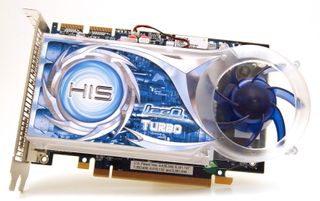Roundup: Mainstream Graphics Cards From ATI And Nvidia
HIS H467QT512P (Radeon HD 4670, 512 MB)
To see all the photos in our gallery for this card, click the image below.

The second HIS variation on the Radeon HD 4670 theme has an active IceQ cooler, which glows blue under ultraviolet light (check the gallery to see this feature in action). Because of the fan housing, this card is two slots wide. The fan and housing circulate air through a channel that picks up heat radiated from the heatsink’s cooling fins and blows it out of your chassis through slots in the front of the card. The Radeon HD 4670 is an efficient and cool GPU that runs fairly quiet at 36.5 dB(A). Even under heavy 3D loads, the fan doesn’t run at high speeds—according to GPU-Z, it stays at a steady 30% of its maximum rotation.
As is typical for HIS, clock rates are slightly elevated on the H467QT512P—the GPU runs at 780 MHz instead of 750 MHz, with the memory clock at the standard 1,000 MHz. The overclocked GPU provides a modest bump to overall performance of about 1.3% (measured in FPS). The clock speed boost comes from a BIOS setting and operates independently of the graphics driver version in use. Its 320 stream processors (SPs) support DirectX 10.1 and Shader 4.0, and the card’s 512 MB of GDDR3 RAM are enough to offer playable speed in some games, even at 1920x1200.
This card clocks all the way down to 165/250 MHz (GPU/RAM) in 2D mode. The retail package omits video cables, and, like the previous board, no power adapter is necessary because the Radeon HD 4670 gets all the power it needs from the PCIe bus. A DVI adapter makes HDMI available, and the card is 7.5" (19 cm) long, including the fan housing. The quiet IceQ cooler improves noticeably upon the Radeon HD 4670 reference design, and helps enable a fairly differentiated product.
Stay on the Cutting Edge
Join the experts who read Tom's Hardware for the inside track on enthusiast PC tech news — and have for over 25 years. We'll send breaking news and in-depth reviews of CPUs, GPUs, AI, maker hardware and more straight to your inbox.
Current page: HIS H467QT512P (Radeon HD 4670, 512 MB)
Prev Page HIS H467PS1GP iSilence (Passively-Cooled Radeon HD 4670, 1,024 MB) Next Page HIS H467QT512P CrossFire (Radeon HD 4670, 2 x 512 MB, CF)-
Bloodblender All I can say is that Tom's recent articles have been an excellent read, and this exactly the stuff I (as well as many others) require for their research purposes. Keep up the great work!Reply -
dirtmountain Nice article,very well done, but you need to show the 4670 in CF as costing $162, not $81 as shown in the final chart.Reply -
rambo117 the iceQ concept is amazing. keeps my 3870s nice and chilly (70C) while hardcore gamingReply
and not to mention they both look intimidating in my case ;) -
to me the gaming benches are most important but energy efficiency and heat dissipation run a close 2nd. thanks for providing it all!Reply
-
Julianbreaker Newegg has quite a few 4850s that retail for $100 and it appears to be getting consistently better benchmarks than the 4770. I am confused as to why you would not recommend it over the 4770. Perhaps you are confused by simple maths.Reply -
radiowars PijQuick question - 4770 in crossfire or single 4890 best bet???..They already did a whole article on that...Reply -
bucifer I don't understand why you still won't use the 1GB version of the Radeon 4870. It's clear to me that the card is limited by it's amount of video memory when using hi-res, AA and AF.Reply
Searching for prices in US and Europe it retails cheaper than the GTX260(192 or 216).
The point is: the card should be included in the test just as the GTX260-216. It's clearly a better option than the 512 mb version and it's good for comparison! -
holodust Nice article, but I don't see how testing these cards on i7 920@3.8 fits into mainstream.Reply
Most Popular

